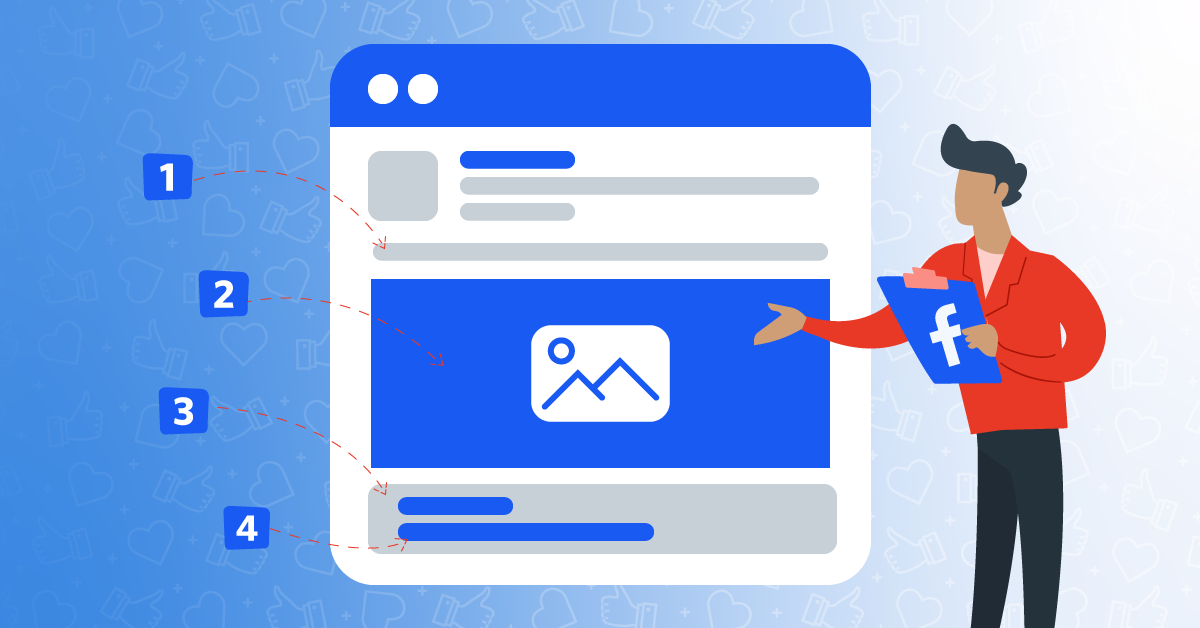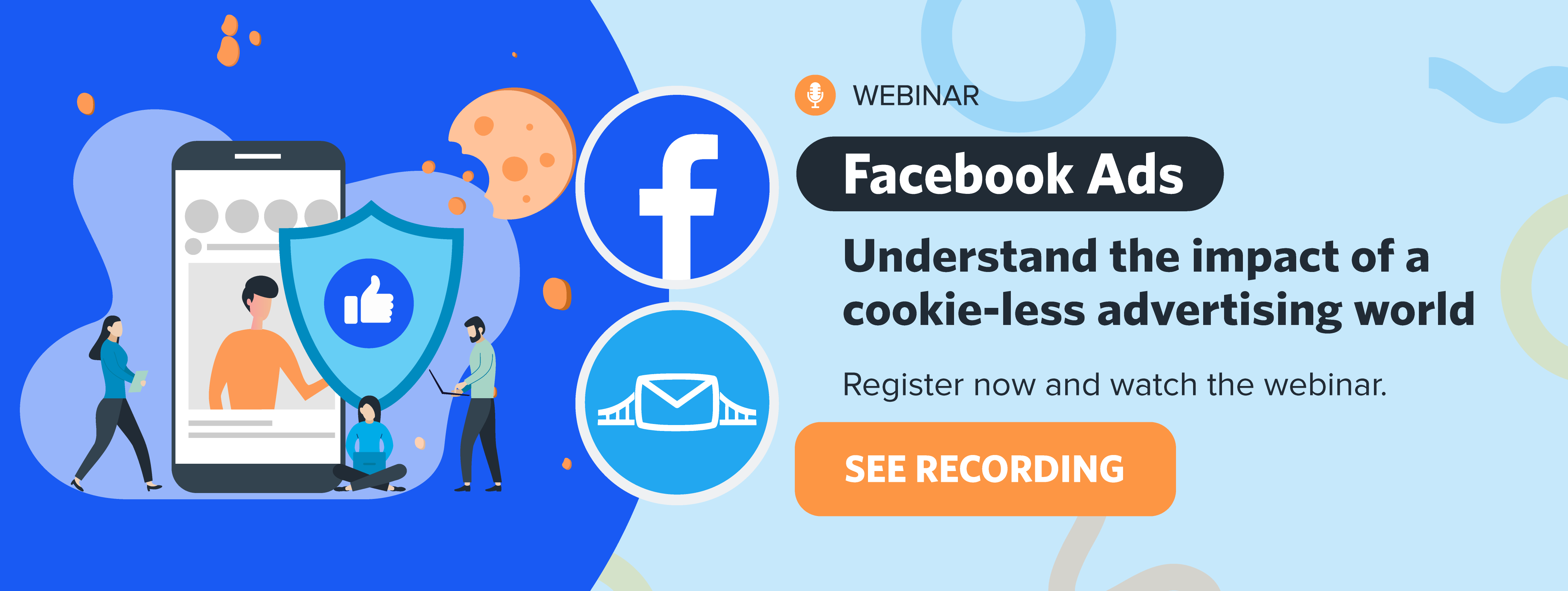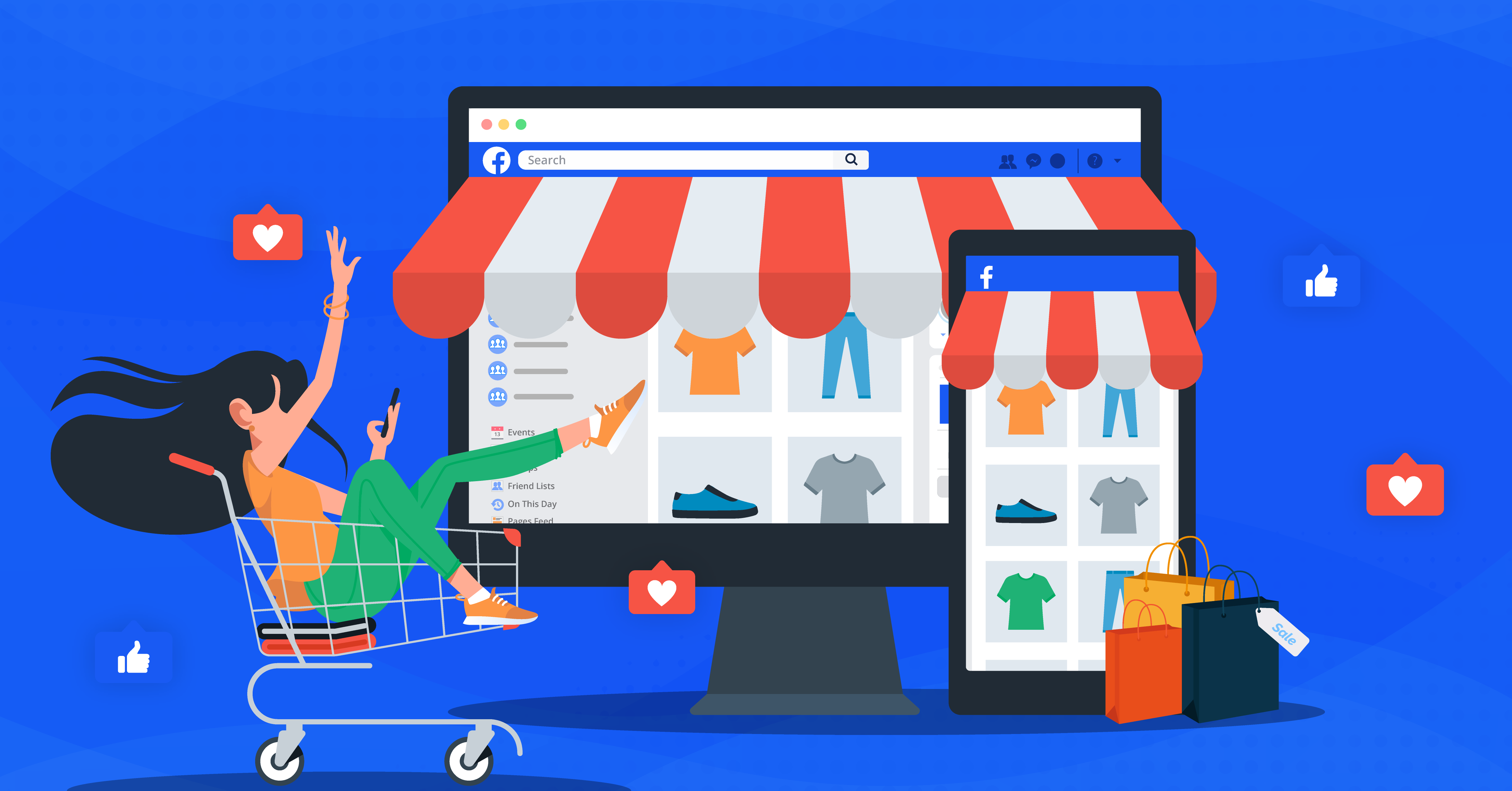
Meta offers so many great advertising features. That’s why it’s no surprise that small businesses and large corporations alike are taking advantage of it to reach their audience and drive leads, onboard customers, and upsell and cross-sell.
- 4 Components that make up the anatomy of a Facebook ad
- 1. The visuals
- 2. The copy
- 3. The clickable call-to-action buttons
- 4. The ad type
- Examples of Facebook canvas ads
- Facebook ad video examples
- Slideshow Facebook ad example
- Facebook Collection Ad examples
- Facebook carousel ad examples
- Single image ads example
- Side column ad example
- Facebook lead ads example
- Instagram story lead ad example
- Conversion ads Facebook example
- Dynamic ads Facebook example
- Facebook Marketplace ad example
- In-stream ads example on Facebook
- 5 Tips for creating a strong Facebook ad
- Final thoughts
However, while Facebook’s self-serve ad system is accessible and relatively easy to learn, knowing how to create high-performing campaigns may take a bit of time and practice.
To help you jumpstart the potential for high-value ad campaigns, in this post, we’re going to break down the anatomy of a Facebook ad. We’ll also go over tips for each component and a few integrations to help you get the results you want.
4 Components that make up the anatomy of a Facebook ad
There are ultimately four different parts that make up the basic anatomy of a Facebook ad: the visual, the copy, the CTA, and the Ad Type.
Let’s take a look at the core parts of a Facebook ad and go over a few tips for how to create strong components across the board.
1. The visuals
Visuals on Facebook ads are essential, and they can either be videos, images, or both. They’re the first thing that users notice, which makes them one of the most important parts of a Facebook ad.

Single media ads let you upload a single video or image.
Carousel ads, story ads, and collection ads all allow you to upload multiple images and/or videos, depending on the format.
Visuals are ultimately what’s going to grab the user’s attention first, so they matter a great deal. You want visuals that highlight your brand’s, service’s, or product’s best features in their best light.
These tips can help you create a strong visual:
- Test mobile-shot video: This is a standard best practice right now, uploading video that looks like it was created by a customer on an iPhone, and it can be successful at driving clicks.
- Keep mobile formatting in mind for your visuals: Mobile-friendliness is essential because more Facebook user activity is happening on mobile than desktop.
- Skip out on models’ faces unless it’s a crucial part of the ad: Ads without faces often perform better than those with faces in them.
- Use software tools: The right tools can ensure the quality is top-notch, and avoid generic or irrelevant visual elements. If you want to create your own images, for example, you can rely on the latest platforms to turn your vision into AI art based on an existing photo, keywords, or prompts.
2. The copy
The copy is the ad text that explains your product, offer, and call to action. It includes your headline, ad description, and micro-copy that can appear in the CTA or overlay on images or videos.

You want your ad copy to really sell your USP and explain why users should take the action you want them to. This could be to make a purchase, sign up for a free class or trial, or complete a lead form.

These are some great Facebook ad body copy examples that do exactly that. Above all, they should explain the benefits of the product or service and why you should purchase now while using a strong brand voice. Here’s an example.

Facebook ad headline
Your ad’s headline basically provides the first impression that either stops someone mid-scroll or lets them pass by. Since you only have 27 characters to work with, you should make every single letter count.
A great headline tells what your product is and what value it brings. It needs to be clear, catchy, and if possible, bring a little personality with it. For instance, with an emoji or the tone it uses. If running an A/B test, you can try turning your headline into the CTA to directly lead people right into clicking that button.
Facebook ads link description
The link description is your chance to add a bit more about your offer. Here’s where you explain why your offer’s worth clicking on and what makes it special.
You can use this spot to add extra info like key features, pricing details, or even a hint of what users can expect when they click. Since this description sits right above the CTA button, it’s a great opportunity to get them excited about what’s next.
3. The clickable call-to-action buttons
Call-to-action buttons are a seemingly small component of your Facebook ad anatomy that can still carry a lot of weight. It shows up at the bottom of your ad next to the headline.
There are plenty of different call-to-action button options like “Shop Now,” “Download,” “Message,” and “Learn More.”

You want to choose your call to action button options wisely. Mostly because it can directly impact how users perceive your ad and whether or not they click.
Someone at the beginning of the funnel might be more likely to click on a “Learn More” CTA than a “Sign Up” or “Shop Now” CTA, which seemingly requires more commitment. Consider testing different Facebook call-to-action buttons for your ads to see what works best.
4. The ad type
There are multiple different ad formats you can choose, including the following:
Examples of Facebook canvas ads
Canvas format features full-screen mobile ads that help highlight brands and products through attractive aesthetics. They are also native ads, which means users can engage with them right on the platform. Let’s look at some examples of canvas ads below.

This is Wendy’s first Canvas campaign, using this format to present their target audience on Facebook with a dismantled cheeseburger.
Facebook ad video examples
Video ads are a crucial element in your social media marketing strategy for their popularity. Additionally, Meta algorithms offer ads to different audiences based on the user’s journey.
So, if you want to reach the people who are likely to engage with your video ads, great video creatives are your best bet.
Let’s look at some Facebook ad video examples:

As you can see, these Facebook ad video examples are classified as Poll Only, Poll + Watch & Browse, Poll + Watch & Install, each offering different features to help increase engagement.
Slideshow Facebook ad example
If you don’t have the means to create an eye-catching video, Slideshow Facebook ads are your next best option. This format lets you combine images and sound to design video-like ads that tell a story. Besides, they are incredibly affordable for marketers and load well at every connection speed.
You can see a slideshow Facebook ad example here:
Source: Mund Mund Media
Facebook Collection Ad examples
Collection ads are designed to help make purchase decisions and improve the user’s experience while doing so. They drive high shopping intent clicks by showcasing a large number of your products at once, increasing the odds of someone seeing something they like.

Once users tap on a collection, they are redirected to a full-screen page to find out more. Check out this popular Facebook collection ad example above.
Facebook carousel ad examples
Meta introduced the carousel ad to replace the single image ads to add creativity and increase engagement. It allows sharing up to 10 images or videos in a single unit that users can scroll through. Additionally, carousel ads have relatively high CTR rates, right after single image and video ads.
Here are some popular Facebook carousel ad examples:


In these Facebook carousel ad examples, you can see how they use this format to highlight various products in a single ad unit or provide more information.
Single image ads example
Not every ad needs a video or outstanding creatives to sell. In some cases, static images and the right ad copy will do just fine. This format presents a single visual for users to focus on.
Instead of using stock photos, branded imagery is the best choice when it comes to single-image ads. You can use models holding your product or just flat images of your product.
Here is how a brand uses single image ads to run successful campaigns.

Side column ad example
Ads in the right-hand column that were previously shown by a small thumbnail (100×72 image), are now displayed in the sidebar with much bigger images (up to 3x).
Right column ads often cost less and can work well for retargeting when users are already familiar with you, but often see fewer CTR than other ad placements. Let’s take a look at the new right column ads example:

Facebook lead ads example
Facebook Lead Ads are one of the most practical ways to generate leads. It allows marketers to connect to people who may be interested in their products or services while collecting information from them.
Once selected, lead ads open to an in-app or on-site lead form that is already pre-populated. Learn more about the most effective examples of lead ads here, along with a couple of case studies.
Considering the amount of marketing competition on the world’s most popular social network, automating your Facebook advertising can help you stand out. LeadsBridge integrations help sync your lead data into your marketing stack in real-time, streamline your campaigns and create instant follow-ups to maximize conversions.
Check out two of our favorite integrations for Facebook marketing.
Instagram story lead ad example
Instagram story lead ads are a great choice for approachable content and brand awareness-focused campaigns. Advertisers can request email addresses or contact details from users who click on their ads with story ads.
This information is collected without taking the users off the platform, and can be used to build newsletter sign-up lists or strategize follow-up calls.

If Instagram lead ads are your area of interest, then you can boost your marketing with these LeadsBridge integrations:
Most ad formats are automatically enabled when you’re creating new ads. Make sure that you’re previewing how both your copy and media look in each ad format and on both mobile and desktop.
Conversion ads Facebook example
Meta conversion leads performance goal helps you to communicate your targeting priorities to Facebook for a campaign. Ads made with this goal are essentially shown to users who are highly likely to become paying customers.
The difference between Facebook’s lead generation with or without conversion leads performance goal is in their intended user actions.
With your usual lead ads, you encourage users to complete a form, whereas selecting this performance goal allows Meta to focus on users who are more likely to take action, such as clicking a link, making a purchase, or watching a video.
To get the most out of these ads, you’ll need to first implement the Conversions API, in addition to (at least) one running lead ads campaign.
In addition to the Conversions API, LeadsBridge lets you integrate your CRM system into Conversion leads performance goal, streamlining the entire workflow. Take a look at this conversion-focused ad example on Facebook by Glenda Ward:

When a user clicks on the links to request an evaluation, Meta considers this as a lead and calculates and charges based on the cost per lead for such actions.
Dynamic ads Facebook example
Dynamic ads show your content and promotions to users who have shown interest in specific products or services. Basically, they promote your inventory to interested users across Meta platforms (Facebook, Instagram, and the Audience Network).
These ads also let you create better personalization, exclude some audience segments, up-sell or cross-sell past customers, and run cross-device targeting.
To get the most out of this feature. You’ll need to install the Meta Pixel on your website. And if you haven’t already, upload your product catalog to Meta. The information that comes in from Meta allows the creation of ad campaigns that target specific audience segments based on their interactions.
These ads work specifically well for ecommerce campaigns in terms of conversion rates. Let’s take a look at this ecommerce dynamic ad Facebook example by Lush Fashion Lounge:

Facebook Marketplace ad example
Marketplace Ads let you focus on the local market and deliver a more wholesome experience to your audiences. Setting up Marketplace ads involves a few steps, selecting your audience, choosing ad formats, creating message templates, and tracking conversions. To track your conversions perfectly, though, you’ll need to step outside Meta’s toolbox domain.
Integrating Marketplace ads with CRM or autoresponders through LeadsBridge can significantly improve your data management.
These integrations also bring better lead management and communication with your existing and potential customers while accessing enough data to create spot-on ad campaigns.

In addition to personal items and property categories, Marketplace on Meta has a dedicated category for car dealerships. This is to help them connect with buyers by reducing friction in the car purchase process. Take a look at these Facebook Marketplace Ad examples:

Importing vehicle listings can be done manually or automatically. Again, automation offers many more benefits, like real-time data syncing with automotive marketing tools.
In-stream ads example on Facebook
In-stream ads are short, engaging video ads that play during videos on Facebook. They are designed to capture attention when users are already in a video-watching mindset. These ads are ideal for brands looking to build awareness or highlight unique product features quickly.
Imagine you’re watching a cooking tutorial on Facebook, and midway through, a quick 10-second ad runs for Buyusus home‘s Double-Wall Glass Insulated Tea Bottle.

This example of in-stream ads on Facebook shows a person effortlessly opening the tea bottle with its one-button lid, with other features like anti-spill structure and double-insulation walls.
After watching, viewers may be more inclined to click “Shop Now” and check out the product, since the ad clearly showcases its unique features and convenience.
5 Tips for creating a strong Facebook ad
There are so many ways you can create a high-performing Facebook ad, but these are our five best tips to get started in the right direction:
Start with your strategy first.
You always want to know what you want a specific ad campaign to accomplish—whether that’s lead, traffic, sales, or reach— before you start. This will impact your entire campaign, including who you target and what copy you use.
Choose your objective carefully.
You may be running a video ad and ultimately want both video views and sales. But what is your priority for this particular campaign? For some, it might be video views so they can create retargeting campaigns on a warmer audience.
Use a full-funnel ad approach.
A Facebook ad funnel accounts for users at all stages of the digital sales funnel, and works to actually nurture users from one stage to the next. Someone who has never heard of your brand won’t respond to the same ad as someone who has purchased three times already.
Use integrations to get the most out of your ads.
There are integrations to streamline your custom audience targeting, sync your lead data, and even push data to your CRM for lightning-fast follow ups. LeadsBridge offers all of these integrations and more.
Here are some of our popular automated data bridges:
Consider letting Meta do the heavy lifting.
One of the best parts about Meta’s ad system (even after iOS 14.5) is that they have incredible machine learning and automation. You can set up dynamic ads or even keep using manually-created ads with different split test versions. This way, you’ll allow Meta to determine who to show the ads to for the best results.
And as always— don’t forget to split test! That’s the best path forward for accessing incredible insights and true optimization.
Final thoughts
The anatomy of a Facebook ad is relatively simple, even if there are so many different options to choose from (and even though the strategy could be complex). Using the right tools can keep your ad management much more streamlined and efficient.
LeadsBridge’s integrations can help you get the most out of the results you get from your campaigns, funneling lead and custom audience information back and forth between Meta, your CRM, your email marketing software, and more. As a result, you can create stronger, full-funnel experiences on Facebook and off of it, making it more powerful of a platform.
Want to learn more about how to get the most out of your Facebook Ads? Check out our Facebook integrations here.
































